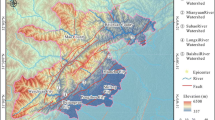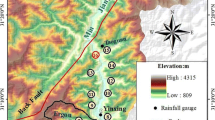Abstract
The 2008 Wenchuan earthquake greatly altered the thresholds for rainfall-triggered debris flows within the affected area. Debris flows were widely and densely distributed, and they exhibited a range of differing local rainfall thresholds. This study looked at 518 debris flow events that occurred post-earthquake in order to analyze their spatial characteristics. The duration D (in h) and the average rainfall intensity I (in mm/h) that triggered the debris flows were determined for 252 of these events in order to analyze the spatial features of rainfall thresholds. Results show that 49 % of debris flows occurred in the highest-intensity seismic zone, 58 % occurred within 10 km of active faults, and 49 % occurred in areas with humid climate. Rainfall thresholds in these three regions were persistently lower than others. Moreover, debris flows were most frequent in watersheds smaller than 5 km2, and rainfall thresholds tended to decrease with a decrease in watershed size. Given the abundant loose materials available throughout the study area, 11 extreme debris flow-prone sub-regions were selected to illustrate the spatial features of rainfall thresholds in relation to local climate conditions. The lowest and highest I–D thresholds in the sub-regions examined were I = 5.94D −0.70 (2 < D < 53) and I = 21.4D −0.58 (3 < D < 50), respectively. The lowest and mean rainfall intensities needed to trigger debris flows were power-related with the local maximum 1- and 24-h rainfall. By normalizing the rainfall intensity (I) by mean annual precipitation (MAP), the I MAP–D thresholds were determined. Normalized results showed that the lowest and highest I MAP–D thresholds were I MAP = 0.0034D −0.55 (2 < D < 53) and I MAP = 0.0090D −0.40 (3 < D < 51), respectively. Such results are useful for debris flow forecasting based on empirical rainfall thresholds and have implications for hazard and risk assessment in this region.












Similar content being viewed by others
References
Aleotti P (2004) A warning system for rainfall-induced shallow failures. Eng Geol 73:247–265
Brunetti MT, Peruccacci S, Rossi M, Luciani S, Valigi D, Guzzetti F (2010) Rainfall thresholds for the possible occurrence of landslides in Italy. Nat Hazards Earth Syst Sci 10:447–458
Burchfiel BC, Chen ZL, Liu YP, Royden LH (1995) Tectonics of the Longmen Shan and adjacent regions, central China. Int Geol Rev 37(8):661–735
Caine N (1980) The rainfall intensity–duration control of shallow landslides and debris flows. Geogr Ann A Phys Geogr 62:23–27
Cannon S, Gartner J, Wilson R, Bowers J, Laber J (2008) Storm rainfall conditions for floods and debris flows from recently burned areas in southwestern Colorado and southern California. Geomorphology 96:250–269
Chen CC, Chen TC, Yu FC, Yu WH, Tseng CC (2005) Rainfall duration and debris flow initiated studies for real-time monitoring. Environ Geol 47:715–724
Chen XC, You Y, Liu JF, Chen H (2011) Characteristics and discrimination of debris flows following Wenchuan earthquake in Qianfoshan scenic spot of Anxian county, Sichuan province, China. Sci Geogr Sin 31(12):1500–1505 (in Chinese)
Cui P, Chen XQ, Zhu YY, Su FH, Wei FQ, Han YS, Liu HJ, Zhuang JQ (2011) The Wenchuan earthquake (May 12, 2008), Sichuan province, China, and resulting geohazards. Nat Hazards 56(1):19–36
Cui P, Zou Q, Xiang LZ, Zeng C (2013) Risk assessment of simultaneous debris flows in mountain townships. Prog Phys Geogr 37(4):516–542
Dahal R, Hasegawa S (2008) Representative rainfall thresholds for landslides in the Nepal Himalaya. Geomorphology 100:429–443
Dai FC, Xu C, Yao X, Xu L, Tu XB, Gong QM (2011) Spatial distribution of landslides triggered by the 2008 Ms 8.0 Wenchuan earthquake, China. J Asian Earth Sci 40:883–895
Fu BH, Wang P, Kong P, Shi PL, Zheng GD (2009) Atlas of seismological and geological disasters associated with the 12 May 2008 Ms 8.0 Wenchuan great earthquake, Sichuan, China. Seismological Press, Beijing, in Chinese
Gabet E, Burbank D, Putkonen J, Pratt-Sitaula B, Ojha T (2004) Rainfall thresholds for landsliding in the Himalayas of Nepal. Geomorphology 63:131–143
Gorum T, Fan XM, van Westen CJ, Huang RQ, Xu Q, Tang C, Wang GH (2011) Distribution pattern of earthquake-induced landslides triggered by the 12 May 2008 Wenchuan earthquake. Geomorphology 133:152–167
Guo DP, Hamada M (2013) Qualitative and quantitative analysis on landslide influential factors during Wenchuan earthquake: a case study in Wenchuan county. Eng Geol 152:202–209
Guo XJ, Xiang LZ, Zhou XJ, Yang W (2012) Research on the debris flow hazards in Gaojia gully and Shenxi gully in 2011. J Catastrophol 27(3):81–85 (in Chinese)
Guo XJ, Cui P, Li Y (2013) Debris flow warning threshold based on antecedent rainfall: a case study in Jiangjia Ravine, Yunnan, China. J Mt Sci 10(2):305–314
Guo XJ, Cui P, Li Y, Zou Q, Kong YD (2015) The formation and development of debris flows in large watersheds after the 2008 Wenchuan earthquake. Landslides. doi:10.1007/s10346-014-0541-6
Guzzetti F, Peruccacci S, Rossi M, Stark C (2007) Rainfall thresholds for the initiation of landslides in central and southern Europe. Meteorog Atmos Phys 98:239–267
Guzzetti F, Peruccacci S, Rossi M, Stark C (2008) The rainfall intensity–duration control of shallow landslides and debris flows: an update. Landslides 5:3–17
Hong Y, Hiura H, Shino K, Sassa K, Suemine A, Fukuoka H, Wang G (2005) The influence of intense rainfall on the activity of large-scale crystalline schist landslides in Shikoku island, Japan. Landslides 2:97–105
Huang RQ, Li WL (2009) Analysis of the geo-hazards triggered by the 12 May 2008 Wenchuan earthquake, China. Bull Eng Geol Environ 68:363–371
Hungr O, Leroueil S, Picarelli L (2014) The Varnes classification of landslide types, an update. Landslides 11(2):167–194
Innes JL (1983) Debris flows. Prog Phys Geogr 7:469–501
Jibson R (1989) Debris flow in southern Puerto Rico. Geol Soc Am 236:29–55
Larsen M, Simon A (1993) A rainfall intensity–duration threshold for landslides in a humid-tropical environment, Puerto Rico. Geogr Ann A Phys Geogr 75:13–23
Li Y, Hu KH, Cui P, Chen XQ, Yue ZQ (2002) Morphology of basin of debris flow. J Mt Sci 20(1):1–11
Liu JF, You Y, Chen XC (2010) The characteristics and countermeasures of dam-breaking debris flow after Wenchuan earthquake—a case study of the Tangfang gully in Pingwu county, Sichuan province. J Sichuan Univ 42(5):68–75 (in Chinese)
Meade BJ (2007) Present-day kinematics at the India–Asia collision zone. Geology 35(1):81–84
Peruccacci S, Brunetti MT, Luciani S, Vennari C, Guzzetti F (2012) Lithological and seasonal control on rainfall thresholds for the possible initiation of landslides in central Italy. Geomorphology 139–140:79–90
Saito S, Nakayama D, Matsuyama H (2010) Relationship between the initiation of a shallow landslide and rainfall intensity–duration thresholds in Japan. Geomorphology 118:167–175
Su PC, Wei FQ, Feng HZ, You Y, Cheng ZL, Xu AS (2011) Causes and effects of group-occurring debris flow disasters in Qingping town, Mianyuan River upstream, Sichuan. J Mt Sci 29(3):337–347 (in Chinese)
Su PC, Wei FQ, Cheng ZL (2012) Debris flow activity of Mozi Gully after Wenchuan earthquake on May 12. J Yangtze River Sci Res Instit 29(2):16–22 (in Chinese)
Tan WP, Han QY (1992) Study on regional critical rainfall indices of debris flow in Sichuan province. J Catastrophol 7(2):37–42 (in Chinese)
Tang C, Zhu J, Li WL (2009) Rainfall triggered debris flows after Wenchuan earthquake. Bull Eng Geol Environ 68:187–194
Tang C, Zhu J, Qi X, Ding J (2011) Landslides induced by the Wenchuan earthquake and the subsequent strong rainfall event: a case study in the Beichuan area of China. Eng Geol 122:22–33
Tang C, Van AT, Chang M, Chen GQ, Zhao XH, Huang XC (2012) Catastrophic debris flows on 13 august 2010 in the Qingping area, southwestern China: the combined effects of a strong earthquake and subsequent rainstorms. Geomorphology 139–140:559–576
Xie H, Zhong DL, Jiao Z, Zhang JS (2009) Debris flow in Wenchuan quake-hit area in 2008. J Mt Sci 27(4):501–509 (in Chinese)
Xu Q (2010) The 13 August 2010 catastrophic debris flows in Sichuan province: characteristics, genetic mechanism and suggestions. J Eng Geol 18(5):596–608 (in Chinese)
Yang DX, Chen XQ, You Y, Liu JF, Chen XC, Zhao WY (2012) The debris flow development trend in Xiaogangjian gully in Mianzhu county, Wenchuan earthquake zone. J Mt Sci 30(6):701–708 (in Chinese)
You Y, Liu JF, Chen XC (2010) Debris flow and its characteristics of Subao river in Beichuan county after 5.12 Wenchuan earthquake. J Mt Sci 28(3):358–366 (in Chinese)
Yu B, Ma Y, Zhang JN, Wu YF, Zhang HH, Li L, Chu SM, Qi X (2011) The group debris flow hazards after the Wenchuan earthquake in Longchi, Dujiangyan, Sichuan province. J Mt Sci 29(6):738–746 (in Chinese)
Zhou W, Tang C (2014) Rainfall thresholds for debris flow initiation in the Wenchuan earthquake-stricken area, southwestern China. Landslides 11(5):877–887
Zhou W, Tang C, Zhou CH (2012) Critical rainfall characteristics for rainfall-induced debris flows in Wenchuan earthquake affected areas. Adv Water Sci 23(5):650–655 (in Chinese)
Zhuang JQ, Cui P, Ge YG, Pei LZ (2009) Hazard assessment of debris flow valleys along Dujiangyan–Wenchuan highway after 5.12 Wenchuan devastating earthquake. J Sichuan Univ 41(3):131–139 (in Chinese)
Acknowledgments
The authors acknowledge the Meteorological Bureau of Sichuan Province for providing rainfall data. This study was supported by the National Natural Science Foundation (Grant No. 41301008), the Key Deployment Project of the Chinese Academy of Sciences (Grant No. KZZD-EW-05-01), and the National Key Technologies R&D Program of China (Grant No. 2012BAK10B04).
Author information
Authors and Affiliations
Corresponding author
Rights and permissions
About this article
Cite this article
Guo, X., Cui, P., Li, Y. et al. Spatial features of debris flows and their rainfall thresholds in the Wenchuan earthquake-affected area. Landslides 13, 1215–1229 (2016). https://doi.org/10.1007/s10346-015-0608-z
Received:
Accepted:
Published:
Issue Date:
DOI: https://doi.org/10.1007/s10346-015-0608-z




